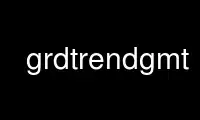
This is the command grdtrendgmt that can be run in the OnWorks free hosting provider using one of our multiple free online workstations such as Ubuntu Online, Fedora Online, Windows online emulator or MAC OS online emulator
PROGRAM:
NAME
grdtrend - Fit trend surface to grids and compute residuals
SYNOPSIS
grdtrend grdfile n_model[r] [ diff.nc ] [ region ] [ trend.nc ] [ weight.nc ]
Note: No space is allowed between the option flag and the associated arguments.
DESCRIPTION
grdtrend reads a 2-D grid file and fits a low-order polynomial trend to these data by
[optionally weighted] least-squares. The trend surface is defined by:
m1 + m2*x + m3*y + m4*x*y + m5*x*x + m6*y*y + m7*x*x*x + m8*x*x*y + m9*x*y*y +
m10*y*y*y.
The user must specify -Nn_model, the number of model parameters to use; thus, -N3 fits a
bilinear trend, -N6 a quadratic surface, and so on. Optionally, append r to the -N option
to perform a robust fit. In this case, the program will iteratively reweight the data
based on a robust scale estimate, in order to converge to a solution insensitive to
outliers. This may be handy when separating a "regional" field from a "residual" which
should have non-zero mean, such as a local mountain on a regional surface.
If data file has values set to NaN, these will be ignored during fitting; if output files
are written, these will also have NaN in the same locations.
REQUIRED ARGUMENTS
grdfile
The name of a 2-D binary grid file.
-Nn_model[r]
n_model sets the number of model parameters to fit. Append r for robust fit.
OPTIONAL ARGUMENTS
-Ddiff.nc
Write the difference (input data - trend) to the file diff.nc.
-R[unit]xmin/xmax/ymin/ymax[r] (more ...)
Specify the region of interest. Using the -R option will select a subsection of the
input grid. If this subsection exceeds the boundaries of the grid, only the common
region will be extracted.
-Ttrend.nc
Write the fitted trend to the file trend.nc.
-V[level] (more ...)
Select verbosity level [c].
-Wweight.nc
If weight.nc exists, it will be read and used to solve a weighted least-squares
problem. [Default: Ordinary least-squares fit.] If the robust option has been
selected, the weights used in the robust fit will be written to weight.nc.
-^ or just -
Print a short message about the syntax of the command, then exits (NOTE: on Windows
use just -).
-+ or just +
Print an extensive usage (help) message, including the explanation of any
module-specific option (but not the GMT common options), then exits.
-? or no arguments
Print a complete usage (help) message, including the explanation of options, then
exits.
--version
Print GMT version and exit.
--show-datadir
Print full path to GMT share directory and exit.
REMARKS
The domain of x and y will be shifted and scaled to [-1, 1] and the basis functions are
built from Legendre polynomials. These have a numerical advantage in the form of the
matrix which must be inverted and allow more accurate solutions. NOTE: The model
parameters listed with -V are Legendre polynomial coefficients; they are not numerically
equivalent to the m#s in the equation described above. The description above is to allow
the user to match -N with the order of the polynomial surface. See grdmath if you need to
evaluate the trend using the reported coefficients.
GRID FILE FORMATS
By default GMT writes out grid as single precision floats in a COARDS-complaint netCDF
file format. However, GMT is able to produce grid files in many other commonly used grid
file formats and also facilitates so called "packing" of grids, writing out floating point
data as 1- or 2-byte integers. To specify the precision, scale and offset, the user should
add the suffix =id[/scale/offset[/nan]], where id is a two-letter identifier of the grid
type and precision, and scale and offset are optional scale factor and offset to be
applied to all grid values, and nan is the value used to indicate missing data. In case
the two characters id is not provided, as in =/scale than a id=nf is assumed. When
reading grids, the format is generally automatically recognized. If not, the same suffix
can be added to input grid file names. See grdconvert and Section grid-file-format of the
GMT Technical Reference and Cookbook for more information.
When reading a netCDF file that contains multiple grids, GMT will read, by default, the
first 2-dimensional grid that can find in that file. To coax GMT into reading another
multi-dimensional variable in the grid file, append ?varname to the file name, where
varname is the name of the variable. Note that you may need to escape the special meaning
of ? in your shell program by putting a backslash in front of it, or by placing the
filename and suffix between quotes or double quotes. The ?varname suffix can also be used
for output grids to specify a variable name different from the default: "z". See
grdconvert and Sections modifiers-for-CF and grid-file-format of the GMT Technical
Reference and Cookbook for more information, particularly on how to read splices of 3-,
4-, or 5-dimensional grids.
EXAMPLES
To remove a planar trend from hawaii_topo.nc and write result in hawaii_residual.nc:
gmt grdtrend hawaii_topo.nc -N3 -Dhawaii_residual.nc
To do a robust fit of a bicubic surface to hawaii_topo.nc, writing the result in
hawaii_trend.nc and the weights used in hawaii_weight.nc, and reporting the progress:
gmt grdtrend hawaii_topo.nc -N10r -Thawaii_trend.nc -Whawaii_weight.nc -V
Use grdtrendgmt online using onworks.net services
